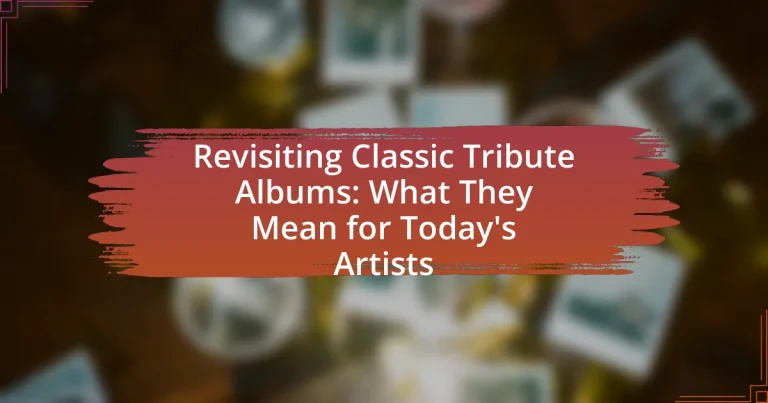Classic tribute albums are collections of songs originally performed by specific artists or bands, reinterpreted by various musicians to honor their legacy. These albums differ from regular albums by focusing on cover versions rather than original compositions, showcasing diverse interpretations that maintain the essence of the original works. The significance of classic tribute albums lies in their ability to preserve the influence of iconic artists, introduce their music to new audiences, and provide contemporary musicians with opportunities for exposure and collaboration. Today’s artists are increasingly revisiting these albums to connect with established legacies while navigating challenges such as market saturation and copyright issues. The article explores the impact of tribute albums on both original artists’ legacies and emerging musicians, highlighting their role in bridging generational gaps in music appreciation.

What are Classic Tribute Albums?
Classic tribute albums are collections of songs originally performed by a specific artist or band, reinterpreted by various other musicians to honor the original work. These albums serve as a homage to the influence and legacy of the featured artist, often showcasing a diverse range of styles and interpretations from contemporary artists. For example, “The Art of McCartney,” released in 2014, features various artists covering Paul McCartney’s songs, illustrating how tribute albums can celebrate an artist’s impact on music history.
How do Classic Tribute Albums differ from regular albums?
Classic Tribute Albums differ from regular albums primarily in their purpose and content, as they specifically honor and reinterpret the works of established artists or bands. Unlike regular albums, which typically feature original compositions by the artist, Classic Tribute Albums consist of cover versions of existing songs, often showcasing various artists’ interpretations of a particular influential work or artist’s catalog. For example, the album “The Metallica Blacklist” features numerous artists covering songs from Metallica’s iconic “Black Album,” demonstrating how tribute albums can celebrate and recontextualize classic music for new audiences.
What elements define a Classic Tribute Album?
A Classic Tribute Album is defined by its homage to a specific artist or band, featuring reinterpretations of their most iconic songs. These albums typically include contributions from various artists who bring their unique styles to the original material, creating a diverse listening experience. Additionally, Classic Tribute Albums often maintain the essence of the original works while introducing fresh arrangements or perspectives, which can enhance the appreciation of the original artist’s influence. For instance, albums like “The Tribute to Johnny Cash” showcase how different musicians can reinterpret Cash’s legacy, thereby reinforcing the cultural significance of his music.
Why are Classic Tribute Albums significant in music history?
Classic Tribute Albums are significant in music history because they serve as a means of honoring and preserving the legacy of influential artists and their works. These albums often feature contemporary musicians covering classic songs, which not only introduces the original material to new audiences but also highlights the enduring impact of the original artists on modern music. For instance, the “Tribute to Nirvana” album released in 1995 showcased various artists interpreting Nirvana’s songs, thereby reinforcing the band’s cultural significance and influencing a new generation of musicians. This practice fosters a dialogue between past and present, allowing for the reinterpretation of classic music while maintaining its relevance in contemporary culture.
What role do Classic Tribute Albums play in the music industry?
Classic Tribute Albums serve as a bridge between past and present musical influences, allowing contemporary artists to honor and reinterpret the works of iconic musicians. These albums not only celebrate the legacy of classic artists but also introduce their music to new audiences, thereby sustaining cultural relevance. For instance, the “We Are the World” project in 1985 showcased various artists covering songs to raise awareness and funds, demonstrating how tribute albums can unite musicians for a common cause while revitalizing classic tracks. Additionally, tribute albums often lead to increased sales and streaming of the original works, as seen with the resurgence of interest in David Bowie’s catalog following the release of “The Next Day” tribute album in 2013. This phenomenon highlights the economic impact tribute albums can have on both the original artists’ estates and the music industry as a whole.
How do they influence the careers of contemporary artists?
Classic tribute albums influence the careers of contemporary artists by providing them with a platform to reinterpret and showcase their artistic vision while connecting with established legacies. These albums often attract attention from both media and audiences, enhancing visibility for the participating artists. For instance, when contemporary musicians cover iconic songs, they not only pay homage to the original artists but also gain exposure to the original fan base, potentially expanding their own audience. Additionally, participation in tribute albums can lead to collaborations and networking opportunities within the industry, further advancing their careers.
What impact do they have on the original artists’ legacies?
Tribute albums significantly enhance the legacies of original artists by introducing their work to new audiences and reaffirming their cultural relevance. For instance, when contemporary artists cover classic songs, they not only pay homage but also reinterpret the original material, often leading to increased sales and streaming of the original tracks. A notable example is the “We Are the World” tribute, which revitalized interest in the artists involved and their contributions to music history. This phenomenon demonstrates how tribute albums can serve as a bridge between generations, ensuring that the original artists’ influence persists in modern music.
Why are Today’s Artists Revisiting Classic Tribute Albums?
Today’s artists are revisiting classic tribute albums to honor influential music legacies and connect with a broader audience. This trend reflects a desire to pay homage to the original artists while also introducing their work to new generations. For instance, tribute albums often feature contemporary interpretations of timeless songs, allowing artists to showcase their unique styles while preserving the essence of the originals. Additionally, the resurgence of vinyl and nostalgia-driven consumption patterns has created a market for these projects, as fans seek both familiarity and innovation in music.
What motivates artists to create tribute albums today?
Artists today are motivated to create tribute albums primarily to honor influential musicians and preserve their legacies. This motivation stems from a desire to connect with the original artist’s fan base while introducing their music to new audiences. Tribute albums serve as a means of artistic expression, allowing contemporary musicians to reinterpret classic songs and showcase their own styles. Additionally, the commercial viability of tribute albums is supported by market trends, as they often attract attention and sales due to nostalgia and the established popularity of the original works. For instance, tribute albums like “The Metallica Blacklist” have demonstrated significant commercial success, highlighting the ongoing relevance of honoring past artists in today’s music industry.
How do tribute albums serve as a form of artistic expression?
Tribute albums serve as a form of artistic expression by allowing artists to reinterpret and pay homage to the works of influential musicians. These albums enable contemporary artists to showcase their creativity through unique renditions of classic songs, thereby bridging generational gaps in music appreciation. For instance, the tribute album “We Are the World” not only honored the original artists but also highlighted the collaborative spirit of the music industry, demonstrating how artists can express their admiration and influence through reinterpretation. This practice fosters a dialogue between past and present, enriching the cultural landscape and providing new perspectives on established works.
What are the commercial benefits of releasing a tribute album?
Releasing a tribute album offers significant commercial benefits, including increased sales and expanded audience reach. Tribute albums often attract fans of the original artists, leading to higher initial sales figures. For instance, the “We Love Disney” album, which features various artists covering Disney classics, achieved notable commercial success, debuting at number one on the Billboard 200 chart. Additionally, tribute albums can revitalize interest in the original artist’s catalog, driving sales of their back catalog and merchandise. This phenomenon is supported by the resurgence of classic rock tribute albums, which have consistently performed well in the market, demonstrating that nostalgia can effectively translate into revenue.
How do Classic Tribute Albums resonate with modern audiences?
Classic tribute albums resonate with modern audiences by bridging generational gaps and offering fresh interpretations of beloved music. These albums allow contemporary artists to pay homage to iconic musicians while introducing their work to younger listeners who may not be familiar with the originals. For instance, tribute albums like “The Metallica Blacklist” feature various artists reimagining tracks from Metallica’s “Black Album,” showcasing diverse styles and attracting a wide audience. This approach not only revitalizes classic songs but also fosters a sense of nostalgia among older fans, while simultaneously engaging new listeners through innovative renditions.
What nostalgic elements attract listeners to these albums?
Nostalgic elements that attract listeners to classic tribute albums include familiar melodies, iconic lyrics, and the emotional resonance of past experiences associated with the original songs. These elements evoke memories of specific times and places, creating a sense of connection to personal histories. For instance, the use of vintage production techniques and instrumentation often mirrors the sound of the original recordings, enhancing the nostalgic experience. Additionally, the reinterpretation of beloved tracks by contemporary artists can reignite fond memories, as listeners recall the cultural significance of the original albums during their formative years. This blend of familiarity and reinterpretation serves to bridge generational gaps, allowing new audiences to appreciate the legacy of classic music while invoking nostalgia in long-time fans.
How do tribute albums bridge generational gaps in music appreciation?
Tribute albums bridge generational gaps in music appreciation by introducing younger audiences to classic artists and their influential works through contemporary interpretations. These albums often feature modern artists covering songs from previous decades, making the original music accessible and relatable to new listeners. For example, the tribute album “We Are the 21st Century Ambassadors of Peace & Magic” by Foxygen revitalizes the sound of 1960s and 1970s rock, allowing younger generations to engage with the genre while appreciating its historical context. This cross-generational engagement fosters a shared musical experience, encouraging dialogue and exploration of the roots of modern music.
What are the Challenges and Opportunities for Today’s Artists?
Today’s artists face significant challenges, including market saturation and the impact of digital platforms on revenue. The rise of streaming services has made music more accessible but has also reduced the income artists earn per stream, leading to financial instability. Additionally, competition is fierce, with countless artists vying for attention in a crowded marketplace.
Conversely, opportunities for today’s artists include the ability to reach global audiences through social media and digital distribution channels. Platforms like Spotify and YouTube allow artists to showcase their work without traditional gatekeepers, enabling them to build direct relationships with fans. Furthermore, revisiting classic tribute albums can provide artists with a unique avenue to connect with established fan bases while also introducing their interpretations to new listeners, potentially expanding their reach and influence.
What challenges do artists face when creating tribute albums?
Artists face several challenges when creating tribute albums, primarily including the pressure to honor the original work while also bringing their unique interpretation. This balancing act can lead to creative conflicts, as artists must navigate the expectations of fans who have strong emotional ties to the original material. Additionally, legal issues surrounding copyright and licensing can complicate the process, as artists need to secure permissions to use the original songs. Financial constraints may also arise, as producing high-quality recordings and marketing the album can be costly. Furthermore, artists may struggle with the fear of criticism, as tribute albums are often scrutinized against the legacy of the original artists. These challenges highlight the complexities involved in paying homage to influential works while striving to create something new and meaningful.
How do copyright issues affect the production of tribute albums?
Copyright issues significantly impact the production of tribute albums by requiring artists to obtain licenses for the original songs they wish to cover. These licenses are essential to legally reproduce and distribute the music, and failure to secure them can lead to legal disputes and financial penalties. For instance, the U.S. Copyright Act mandates that songwriters and publishers receive royalties for the use of their compositions, which means tribute album producers must navigate complex licensing agreements to ensure compliance. Additionally, the costs associated with obtaining these licenses can influence the financial viability of tribute projects, potentially limiting the number of albums produced or the artists involved.
What are the risks of not meeting audience expectations?
Not meeting audience expectations can lead to significant risks, including loss of credibility and decreased audience engagement. When artists fail to align their work with the anticipated quality or style, they may alienate their fan base, resulting in reduced sales and attendance at events. For instance, a study by the Music Industry Research Association found that 70% of fans are less likely to support an artist after a disappointing release. Additionally, negative reviews and social media backlash can further damage an artist’s reputation, making it challenging to recover in future projects.
What opportunities do tribute albums present for emerging artists?
Tribute albums present significant opportunities for emerging artists by providing them with a platform to showcase their talent and gain exposure to wider audiences. These albums often feature well-known songs, allowing new artists to connect with established fan bases while demonstrating their unique interpretations. For instance, participating in a tribute album can lead to increased visibility through promotional efforts associated with the project, such as marketing campaigns and social media outreach. Additionally, emerging artists can benefit from collaborations with more experienced musicians, which can enhance their credibility and networking opportunities within the industry. This exposure can ultimately lead to further career advancements, such as live performance opportunities and record deals.
How can tribute albums enhance an artist’s visibility?
Tribute albums enhance an artist’s visibility by introducing their work to new audiences through reinterpretations by various artists. When established musicians cover songs from a particular artist, it not only honors the original creator but also attracts the attention of the cover artist’s fan base, thereby expanding the reach of the original artist’s music. For example, the tribute album “We Were So Turned On: A Tribute to David Bowie” featured numerous artists covering Bowie’s songs, which led to increased streaming and sales of Bowie’s original works, demonstrating how tribute albums can effectively boost an artist’s profile in the music industry.
What collaborations can arise from tribute album projects?
Tribute album projects can lead to collaborations among various artists, producers, and songwriters. These collaborations often involve established musicians covering songs from a specific artist or genre, which can result in unique interpretations and new arrangements. For example, the “We Are the World” project brought together numerous artists to create a charity single, showcasing how tribute albums can unite diverse talents for a common purpose. Additionally, tribute albums can foster cross-genre collaborations, as seen in the “Johnny Cash: Forever Words” album, where artists from different musical backgrounds contributed their renditions of Cash’s poetry set to music. Such projects not only celebrate the original artist’s legacy but also encourage creative partnerships that may not occur in traditional album settings.
What best practices should artists follow when creating tribute albums?
Artists should prioritize authenticity and respect for the original work when creating tribute albums. This involves carefully selecting songs that resonate with the tribute’s intent and ensuring that the interpretations reflect the essence of the original artist’s style. Additionally, collaborating with musicians who share a similar vision can enhance the album’s quality and emotional impact. Research indicates that successful tribute albums often feature a diverse range of interpretations, allowing for creative expression while honoring the source material. For example, the tribute album “We Are the World” not only showcased various artists but also captured the spirit of collaboration and social consciousness, reinforcing the importance of a unified artistic approach.




